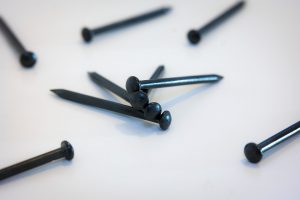
Nails are frequently used in the woodworking construction industries to join two or more objects. Typically consisting of a long and slender metal shaft with a sharp point on one end and a flattened head on the other end, they are used in conjunction with a tool, such as a hammer or nail gun. The sharp end is forced through the respective objects, at which point the objects become joined together. Even if you’re familiar with the basic function of a nail, though, you might be surprised to learn the history behind this otherwise common fastener.
Origins of the Nail
It’s unknown when exactly nails were invented. With that said, archeologists have found nails in Egypt dating back to around 3,400 B.C. Made of all bronze, they featured the same characteristic shape and design as those manufactured today. With that said, some historians believe that nails were around prior to 3,400 B.C. Regardless, it’s safe to say that the modern nail is thousands of years old.
The Rise of Nailers
Throughout much of history, nails were handmade by skilled professionals known as nailers. Metalworkers would first create long and slender shafts of metal, typically using heated iron, after which they would pass these objects to a nailer. The nailer would then hammer and work the iron shaft to create the final design of a nail. It wasn’t until the turn of the 19th century when the slitting mill was pioneered. Using a slitting mill, metalworkers were able to mass-produce nails without the need for nailers.
How the American Revolution Led to a Nail Shortage
It’s a little-known fact that the American Revolution led to a widespread nail shortage throughout the country. Back then, most nails were manufactured and sold in England. Once the 13 American colonies declared independence from England, England stopped supplying them with nails. Nails were in such as a short supply, in fact, that many communities would burn down old houses and building just to recover the nails.
The Cut-Nail Process
In 1795, an American entrepreneur named Jacob Perkins invented the cut-nail process. What is the cut-nail process? Basically, it involves cutting nails from sheets or raw iron. The advent of the cut-nail process led to a new era in the nail-making industry, allowing companies to produce nails more quickly and efficiently.
Today, there’s no longer nail shortage. In the United States as well as the United Kingdom, nails are mass-produced in large volumes, with roughly 90% of all nails produced being wire nails.
